Top dog: a series of lakefront kiosks reinvent the hot dog stand in Chicago
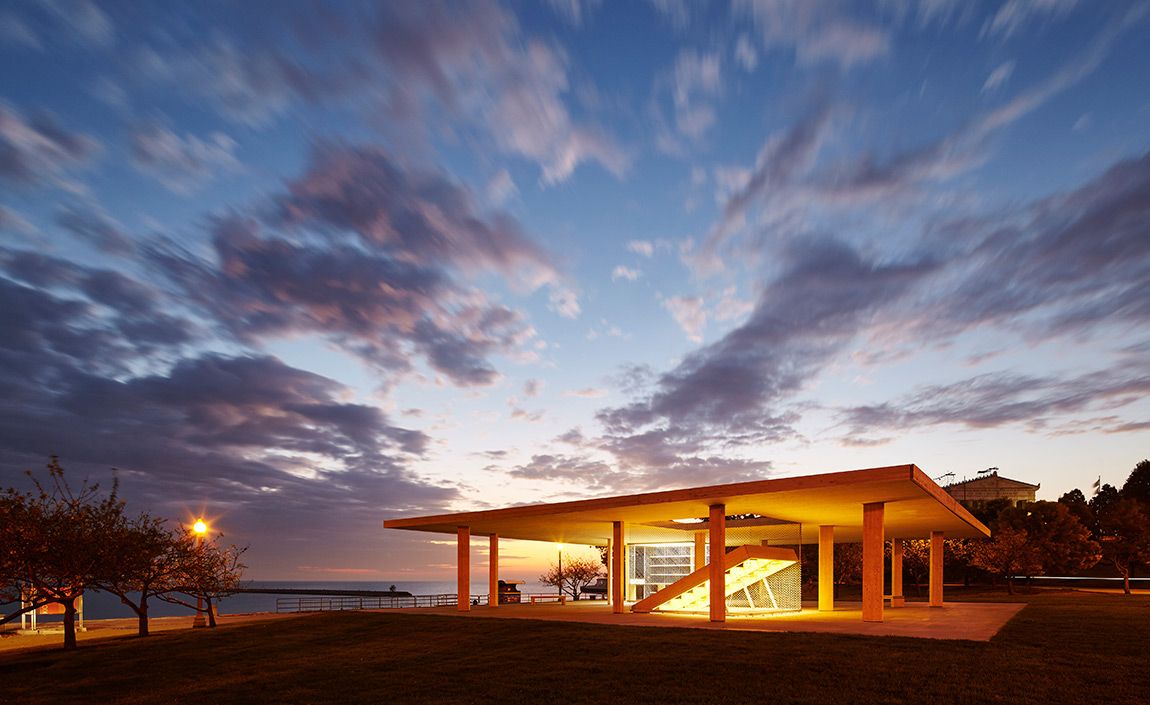
Chicago, a city known for its architecture, also has another claim to fame: hot dogs. But until now, those two points of pride have been kept mostly separate. The skyline may be filled with landmarks of architectural history, but hot dogs tend to be vended in rickety kiosks.
When plans for the Chicago Architecture Biennial started taking shape, Sarah Herda and Joseph Grima, the event's co-artistic directors, were determined to leave a lasting impression on the city. There would be temporary exhibitions, of course, but they wanted to use the biennial platform as a way to commission permanent structures. With this in mind, they set their sights on some of these modest off-the-shelf vending kiosks -'hot-dog stands,' as Herda calls them - that dot the long stretch of public space along the city's lakefront.
In partnership with the Chicago Park District, a design competition, which drew over 400 submissions, asked architects to imagine new lakefront kiosks. The winning team, Ultramoderne's Yasmin Vobis and Aaron Forrest, and structural engineer Brett Schneider, unveiled their kiosk during the biennial's recent opening proceedings. Made with cross-laminated timber, the 17m2 canopy offers shade, while an opening in the roof provides a unique way to view the surrounding horizon. Situated on the lakefront just north of the Field Museum, the pavilion is intended to operate as a library during the biennale before it becomes a commercial vending space.
The biennial organisers also commissioned three other kiosks by pairing local schools with established firms. The University of Illinois at Chicago partnered with two firms, Independent Architecture and Paul Preissner Architects, to create a light blue barrel vault, now positioned directly adjacent to Anish Kapoor's Cloud Gate. IIT College of Architecture and Pezo von Ellrichshausen created a series of stacked hexagonal volume that reach upward like a telescoping ziggurat, now on view just outside IIT's Crown Hall. For the third, the School of the Art Institute of Chicago worked with NLÉ on a system of limestone and concrete elements that can be reconfigured based on need.
When the biennial officially closes on January 3, 2016, these four structures will remain, and, during the spring of 2016, the city will position them along the waterfront, where they will allow vendors to sell their products, hot dogs or otherwise. Organisers hope to repeat the process for subsequent biennials. As Herda envisions, "the grand plan would be to replace the old structures incrementally and make a trail of contemporary architecture."
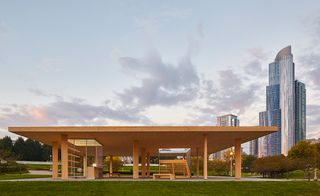
The project, created in partnership with the Chicago Park District, asked participants to reimagine the lakefront kiosk
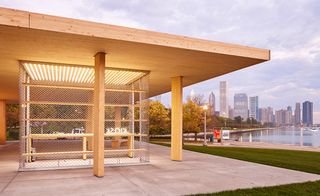
Made with cross-laminated timber, the 17m2 canopy offers shade, while an opening in the roof provides a unique way to view the surrounding horizon
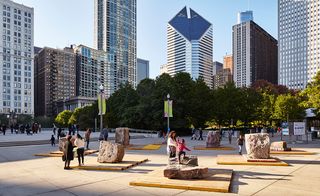
The biennial organisers also commissioned three other kiosks by pairing local schools with established firms
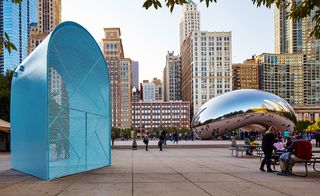
The University of Illinois at Chicago partnered with two firms, Independent Architecture and Paul Preissner Architects, to create a light blue barrel vault, now positioned directly adjacent to Anish Kapoor's Cloud Gate
INFORMATION
Photography: Tim Harris
Wallpaper* Newsletter
Receive our daily digest of inspiration, escapism and design stories from around the world direct to your inbox.
-
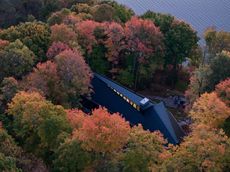 A new lakeshore cottage in Ontario is a spectacular retreat set beneath angled zinc roofs
A new lakeshore cottage in Ontario is a spectacular retreat set beneath angled zinc roofsFamily Cottage by Vokac Taylor mixes spatial gymnastics with respect for its rocky, forested waterside site
By Jonathan Bell Published
-
 Steve McQueen presents a portrait of protest in Britain
Steve McQueen presents a portrait of protest in BritainTurner Contemporary’s groundbreaking exhibition Resistance reframes the history of protest, reminding us of photography’s political potential
By Millen Brown-Ewens Published
-
 Chanel has made a face massage tool from the husks of camellia flower seeds
Chanel has made a face massage tool from the husks of camellia flower seedsChanel Beauty’s new gua sha-inspired tool, designed by in-house experts for rejuvenating facial massage, is the latest launch from its sustainable skincare line, No.1 de Chanel
By Anna Solomon Published
-
 Apple’s new Miami store employs the principles of biophilic design
Apple’s new Miami store employs the principles of biophilic designApple’s first mass-timber store connects shoppers to nature while echoing the Art Deco architecture of Miami
By Anna Solomon Published
-
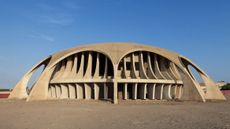 The World Monuments Fund has announced its 2025 Watch – here are some of the endangered sites on the list
The World Monuments Fund has announced its 2025 Watch – here are some of the endangered sites on the listEvery two years, the World Monuments Fund creates a list of 25 monuments of global significance deemed most in need of restoration. From a modernist icon in Angola to the cultural wreckage of Gaza, these are the heritage sites highlighted
By Anna Solomon Published
-
 Reflections from Los Angeles: a local writer's personal account of the LA fires
Reflections from Los Angeles: a local writer's personal account of the LA firesArchitecture writer and local resident Michael Webb reflects on the devastating 2025 Los Angeles fires and offers his personal account of the events of the last two weeks in California
By Michael Webb Published
-
 LA Mayor Karen Bass outlines her plan for rebuilding the city
LA Mayor Karen Bass outlines her plan for rebuilding the cityFollowing the devastating LA wildfires, which have destroyed more than 12,000 structures, the city’s mayor has outlined her plan for reconstruction
By Anna Solomon Published
-
 Frank Lloyd Wright’s Weisblat House, a Usonian modernist Michigan gem, could be yours
Frank Lloyd Wright’s Weisblat House, a Usonian modernist Michigan gem, could be yoursFrank Lloyd Wright’s Weisblat House in Michigan is on the market – a chance to peek inside the heritage modernist home in the countryside
By Audrey Henderson Published
-
 Cabin House is a simple modernist retreat in the woods of North Carolina
Cabin House is a simple modernist retreat in the woods of North CarolinaDesigned for downsizing clients, Cabin House is a modest two-bedroom home that makes the most of its sylvan surroundings
By Jonathan Bell Published
-
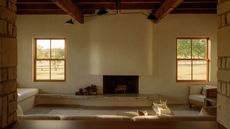 A Texas ranch house blends Californian charm and Asian minimalism in a 'balance in hybridity'
A Texas ranch house blends Californian charm and Asian minimalism in a 'balance in hybridity'Pontious, a Texas ranch house designed by OWIU, is a home grounded in its owner's cultural identity, uniting Californian, Chinese and Japanese roots
By Tianna Williams Published
-
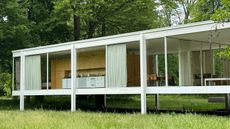 The three lives of the Edith Farnsworth House: now, a modernist architecture icon open to all
The three lives of the Edith Farnsworth House: now, a modernist architecture icon open to allThe modernist Edith Farnsworth House has had three lives since its conception in 1951 by Mies van der Rohe; the latest is a sensitive renovation, and it's open to the public
By Audrey Henderson Published